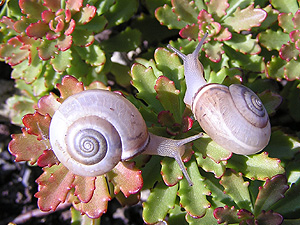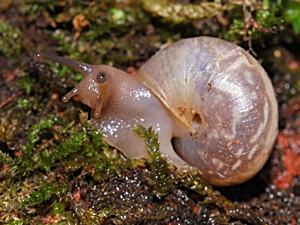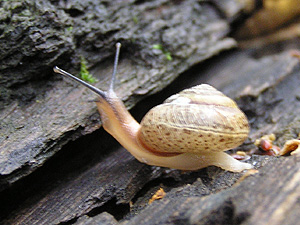| Diese Seite auf Deutsch! |
|
Leaf Snails (Hygromiidae) Part 1 |
| Monacha, Perforatella |
| Leaf Snails (Hygromiidae) I | Leaf Snails (Hygromiidae) II | Leaf Snails (Hygromiidae) III | Heath Snails (Geomitridae) |
|---|---|---|---|
|
|
|
|
Leaf and bush snails (Hygromiidae) are a very diverse family of terrestrial pulmonate snails (Stylommatophora), which by some older authors are still presented as subfamiliy of the helicid snails (Helicidae). Hygromiids are small to middle sized, so in general they are somewhat smaller than helicid snails. Among the species living in leaf litter and on trees, brownish shell colours are prevalent, while the xerophilous (dryness-tolerant) species of heath snails (Geomitridae), the shells are rather whitish with dark bands. Also, the shells of species living in more humid habitats are rather thin walled and often covered in hairs, while the xerophilous species are more thickly walled and hairless. A love dart is present in many species, albeit not all of them.
 Incarnate snail (Perforatella incarnata). Photo: Robert Nordsieck. |
|
 Kentish snail (Monacha cantiana): West Midlands, Great Britain. Photo: Lukas Large (iNaturalist). |
|
 Bidentate leaf snail (Perforatella bidentata): Kaunas, Lithuania. Picture: Romas Ferenca (iNaturalist). |
Today it is estimated that in Europe, about 50 species of hygromiid snails are present. The family altogether is distributed palaearcitcally: From the Azores and Canary Island throughout Europe and North Africa as far as Central Asia, Hygromiidae species can be found.
Systematically, much remains unclear about hygromiid snals. Especially the classification of partial groups as subfamilies or so-called tribes (between subfamily and genus), there is not necessary a unity of opinions.
Order: Stylommatophora
![]()
![]() Suborder: Helicina
Suborder: Helicina
![]()
![]() Superfamily: Helicoidea
Superfamily: Helicoidea
![]()
![]() Family: Hygromiidae Tryon
1866
Family: Hygromiidae Tryon
1866
Family Hygromiidae Tryon, 1866
![]()
![]() Subfamily:
Hygromiinae Tryon,
1866
Subfamily:
Hygromiinae Tryon,
1866
![]()
![]() Tribe: Hygromiini Tryon, 1866
Tribe: Hygromiini Tryon, 1866
![]()
![]() Genus: Hygromia
Risso, 1826
Genus: Hygromia
Risso, 1826
![]()
![]() Tribe: Perforatellini Neiber, Razkin
& Hausdorf, 2017
Tribe: Perforatellini Neiber, Razkin
& Hausdorf, 2017
![]()
![]() Genus:
Perforatella
Schlüter, 1838 (formerly Monachoides)
Genus:
Perforatella
Schlüter, 1838 (formerly Monachoides)
![]()
![]() Subfamily: Trochulininae Lindholm,
1927
Subfamily: Trochulininae Lindholm,
1927
![]()
![]() Tribe Ciliellini Schileyko, 1970
Tribe Ciliellini Schileyko, 1970
![]()
![]() Genus
Ciliella
Mousson, 1872
Genus
Ciliella
Mousson, 1872
![]()
![]() Tribe Monachaini Wenz, 1930 (1904)
Tribe Monachaini Wenz, 1930 (1904)
![]()
![]() Genus:
Euomphalia Westerlund, 1889
Genus:
Euomphalia Westerlund, 1889
![]()
![]() Genus:
Monacha
Fitzinger, 1833
Genus:
Monacha
Fitzinger, 1833
![]()
![]() Tribe Trochulini Lindholm, 1927
Tribe Trochulini Lindholm, 1927
![]()
![]() Genus:
Noricella
Neiber, Razkin
& Hausdorf, 2017
Genus:
Noricella
Neiber, Razkin
& Hausdorf, 2017
![]()
![]() Genus:
Petasina
H. Beck, 1847
Genus:
Petasina
H. Beck, 1847
![]()
![]() Genus
Trochulus
Chemnitz, 1786
Genus
Trochulus
Chemnitz, 1786
![]()
![]() Tribe Urticicolini Neiber, Razkin
& Hausdorf, 2017
Tribe Urticicolini Neiber, Razkin
& Hausdorf, 2017
![]()
![]() Genus:
Urticicola Lindholm, 1927
Genus:
Urticicola Lindholm, 1927
![]() Source:
MolluscaBase eds. (2025):
Hygromiidae Tryon,
1866.
Source:
MolluscaBase eds. (2025):
Hygromiidae Tryon,
1866.
Heath snails, on the other hand, among those the Central and East European genera Helicella, Xerolenta, Cernuella and Helicopsis, as described on the page heath snails (Geomitridae), according to the paper published in 2015 by Razkin et al., are no longer counted among the Hygromiidae, but are placed in an own family Geomitridae, divided into several subfamilies and tribes. The systematic order of Geomitridae is described on the appropriate page.
![]() Explanation of
shell characters for
identification.
Explanation of
shell characters for
identification.
Carthusian Snail - Monacha cartusiana (O. F. Müller 1774)
 Carthusian snail (Monacha cartusiana). |
 Photos: Robert Nordsieck. |
Description: The Carthusian snail has a milky greyish white to yellowish white shell with a flat conical spire. Around the shell mouth (aperture) the shell can be coloured in a brown or reddish tone. Translucent weak brownish bands can be visible, growing pale towards the aperture. The shell navel (umbilicus) is very narrow and partly covered by the apertural lip.
Dimensions: W: 9 - 15 mm; H: 6 - 10 mm; N: 5 ½ - 6 ½.

Habitat and Distribution: The Carthusian snail prefers sunny and dry bushes and grassy slopes, hedgerows and roadsides in lower altitudes. Above 500 m MSL it is rare.
The species' distribution spreads over the entire European Mediterranean and the Black Sea region, in the West from France as far as southeastern England and the southern Netherlands, in Germany into the Rhine valley; in the East as far as Hungary and dispersed into Slovakia and eastern Austria. The species has often been introduced and therefore also occurs in isolated places.
Apart from other snail species, Monacha cartusiana can also be an intermediate host for the lesser liver fluke (Dicrocoelium lanceolatum).
Kentish Snail - Monacha cantiana (Montagu 1803)
 Kentish snail (Monacha cantiana). Photo: Brian Eversham (Source). |
Source: Hlaváč, Peltanová (2010). |
Description: The Kentish snail has a creamy white to reddish brown shell, juvenile specimens of which can have a shell surface covered in hairs. The whorls are somewhat rounded; the spire can be flat or nearly conical. The aperture displays a whitish to reddish lip, which, however, is less pronounced than in Monacha cartusiana. The shell navel (umbilicus) is slightly wider than in Monacha cartusiana (see below), measuring about one seventh of the overall shell diameter.
The snail itself is lightly coloured; the frontal part of the body is reddish with greyish brown tentacles. The snail is rather slow, easily scared and then secretes a colourless slime.
Dimensions: W: 16 - 20; H: 11 - 14 mm; N: 5 - 6.

Habitat and Distribution: The Kentish snail lives in the undergrowth of hedgerows, in fallow land and in bushes. It can be found at the roadside, on railway embankments; it is even present in sand dunes, however not in forested areas. Monacha cantiana prefers well drained up calcareous soils. Especially juvenile specimens often aestivate for longer periods of time, hanging on plants in some altitude.
 Kentish snail (Monacha cantiana). Photo: Brian Eversham (Source). |
Historically, the Kentish snail originates from Italy and southern France. From there, it has been introduced to northern France, Belgium, the Netherlands and northern Germany, as well as in the eastern part of Austria around Vienna. In recent time, it has also been found as a neozoon in Czechia. Newly established populations are found mainly in recently planted roadside and railway embankment vegetation, as they are introduced there together with the plants. Similar to the maritime garden snail (Cernuella virgata), Monacha cantiana also occurs on abandoned railway grounds overgrown with ruderal vegetation.
In Great Britain, where the Kentish snails has been described from first, it had been introduced by farmers during the late Roman period. Especially during the Middle Ages the largest distribution took place, so that today the Kentish snail is distributed in a continuous area in southern and eastern England. There are also isolated presences in Wales, the western Midlands, as well as in northern England (Yorkshire) and Scotland. In Ireland the species was not able to maintain its presence.
Threat Situation: In Lower Saxony and for some time in all of Germany,
the Kentish snail, due to its dispersed distribution, has been threatened by
extinction (![]() Threat categories according to IUCN
Red List).
Threat categories according to IUCN
Red List).
Incarnate Snail - Perforatella incarnata (O. F. Müller 1774)
 Incarnate snail (Perforatella incarnata). Photo: Robert Nordsieck. |
 Perforatella incarnata: Escublens, Switzerland. Photo: Nicolas Zwahlen (iNaturalist). |
 
Perforatella incarnata. Photo: Helmut Nisters. |
Description: The incarnate snail's name is due to the reddishly coloured apertural area of its shell. Other than that, the rest of the shell is less reddish, usually more yellowish horn coloured to reddish brown. The shell surface is almost smooth with a slight scaly structure. The flatly conical spire renders the shell a depressed spherical form. The apertural lip in adult specimens is strong and thickened at the basal side. The shell navel (umbilicus) is narrow, but open and only partially covered by the apertural lip.
Dimensions: W: 13 - 16 mm; H: 9 - 11 mm.

Habitat and Distribution: The incarnate snail is a ground dwelling species living in the leaf litter of moderately humid forests, under bushes and in between rocks and boulders. Only the juveniles crawl up plants in the herb vegetation.
The species' distribution area reaches in the West as far as central France, in the South from the southern Alps as far as Bulgaria, in the East as far as the western Carpathians. In the North German lowlands, the species can be found as far East as the Oder River, in the Niorth until southern Sweden. In the Southeast of England, the incarnate snail has been introduced by farmers in prehistoric times.
Threat Situation: Because of the agricultural development in
Great Britain the incarnate snail has been receding dince the end of the 19th
century. Most surviving populations are considered threatened. In northern
Switzerland, the species is threatened, in the remaining part of Switzerland, it
is near threatened. In England, the species is rare (![]() Threat categories).
Threat categories).
Systematics: According to Adamcová et al. (2024) the genus Monachoides, on the grounds of molecular genetic research results is to be dissolved and the incarnate snails is to be placed in a new genus as Perforatella incarnata.
Bidentate Leaf Snail - Perforatella bidentata (Gmelin 1791)
 Bidentate leaf snail (Perforatella bidentata) from Romania. Photo: © Alexander Mrkvicka, Vienna. |
 Perforatella bidentata. Photo: O. Gargominy. |
The difference to the similar edentate hair snail (Petasina edentula), are the bidentate leaf snail's two apertural teeth and the more conical shell spire.
Dimensions: H: 5 - 7 mm; W: 6,5 - 9 mm; N: 7 - 8.

Habitat and Distribution: The bidentate leaf snail inhabits very humid deciduous forests and alder marsh forests, living on the forest floor, in the leaf litter and on deadwood. The species is rarely found in habitats disturbed by humans. In Schleswig-Holstein in Northern Germany, it occurs, for instance, mainly in the eastern hill country, in the West only in a dispersed manner on calcareous ground.
The species' distribution area spreads from Germany as far as Sweden and the Russian region of St. Petersburg as far as Novgorod, in the Southeast into the Volga basin and Eastern Ukraine (Kharkiv), as well as Romania.
Threat Situation: In Germany, Perforatella bidentata is
classified as threatened (![]() Threat categories).
Threat categories).
Links
Literature
 With photos by Stefan Haller: http://www.schneckenfoto.ch. |
Latest Change: 28.09.2025 (Robert Nordsieck).